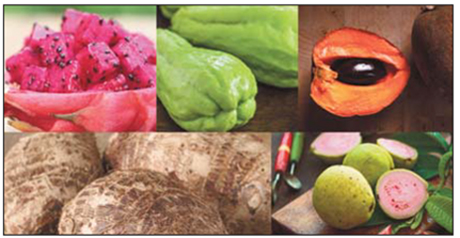Welcome to Blue Book!
Are you ready to join the thousands of companies who rely on Blue Book to drive smarter decisions? View our plans and get started today!
Still have questions? We’d love to show you what Blue Book can do for you. Drop us a line– we’ve been waiting for you.

After being picked, guava is kept in a cooler until delivery, then it goes straight to a refrigerated display area. The fruit should not ripen at room temperature until the skin changes from green to yellow; once ripe, guavas have a shelf life of about two weeks. The succulent fruit can be peeled and eaten raw—the taste runs from sweet to tart, depending on the level of ripeness—but is typically used to make jams, jellies, or filling for tarts and pastries.
MARVELOUS MAMEY SAPOTE
Mamey sapote: zapote colorado, níspero, zapote rojo—so many names, so much confusion, all over a sweet, delectable fruit. Native to Central America, the mamey (Pouteria sapota) has a thick, woody brown outer skin and flesh that ranges from pale pink to a deep salmon color when fully ripe. There are two common mamey sapotes: the larger football-shaped Magana mamey and the smaller, rounder Key West variety, known as Pantin mamey sapote.
On average, a mamey is about four to ten inches long, and can weigh as much as eight pounds. Inside, the fruit is creamy and sweet, often described as having pumpkin, persimmon, and berry undertones; the center holds a large, dark, almond-shaped pit.
According to New Limeco’s Caram, mamey is steadily rising in popularity. Unfortunately, it’s also restricted as an import due to its susceptibility to whiteflies; the only mamey available to U.S. consumers is grown in South Florida. But that doesn’t mean demand is going away.
“Right now we’re seeing 100 percent growth year-over-year in mamey sales,” points out Caram, who predicts explosive growth in demand over the next five years. “It’s definitely becoming very mainstream.”
The key is to pick it the day before shipping. From field to cooler to refrigerated truck, once the shipment reaches the store level, the fruit should be kept at room temperature. Mamey ripens completely within two to three days. Once ripe, it’s good for up to three days if refrigerated.
While the sweet fruit is delicious on its own, it’s more common to find mamey in ice cream and paletas (Mexican frozen fruit bars). Among Cubans, mamey is wildly popular and most often consumed as a batido de mamey (smoothie) or in a daiquiri. The flesh can also be frozen for later use.
THE MYSTERIES OF MALANGA
Also known as yautía, cocoyam, and tannia depending on the country, malanga is a root vegetable commonly found in Caribbean cuisine. Of the many varieties (coco, isleña, lila, blanca, and amarilla)—the two most widely consumed are malanga blanca (white malanga, Xanthosoma sagittifolium), which grows on dry land, and malanga amarilla (yellow malanga, Colocasia esculenta), which prefers damp, even boggy, conditions. The skin is hairy and rough, ranging in color from reddish to dark brown, and the flesh can be cream-colored, yellow-tinged, or light pink.




